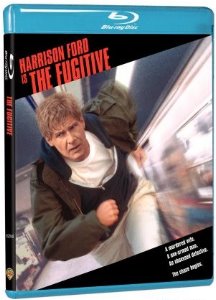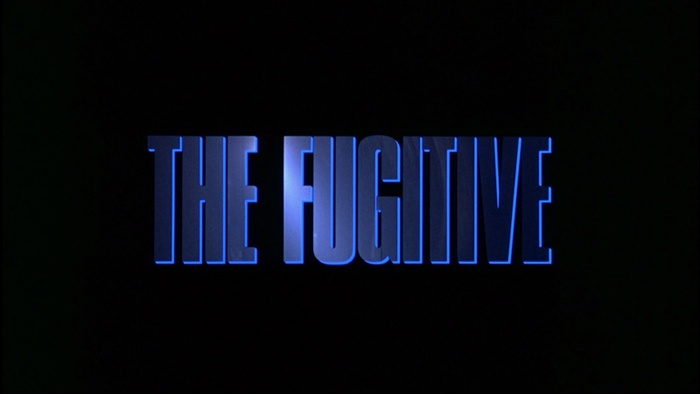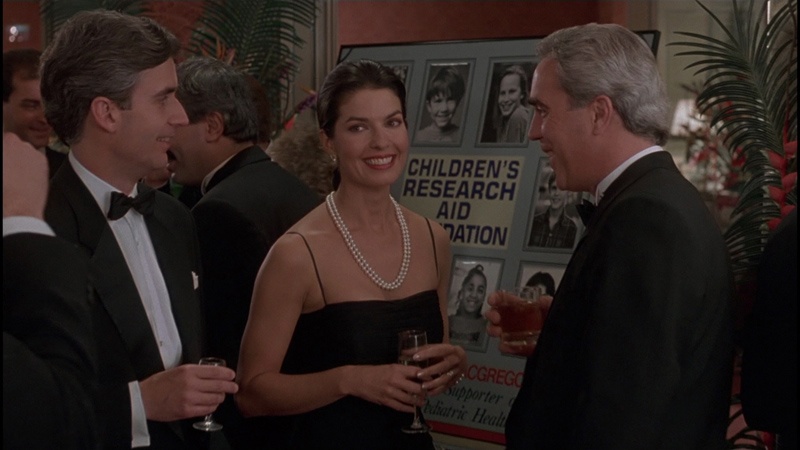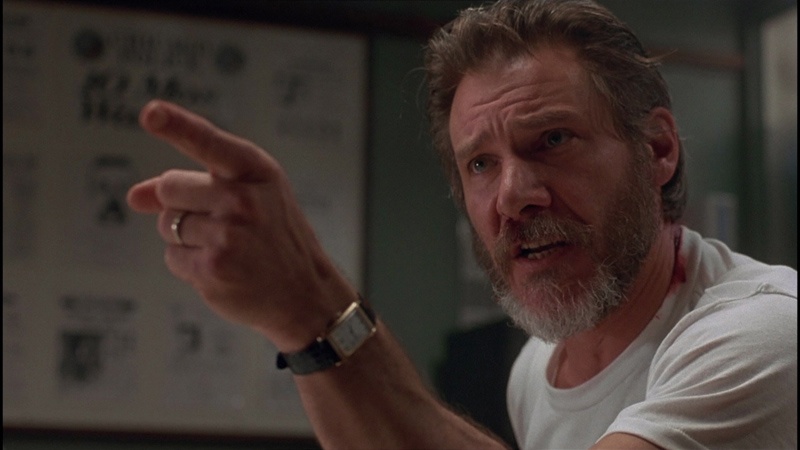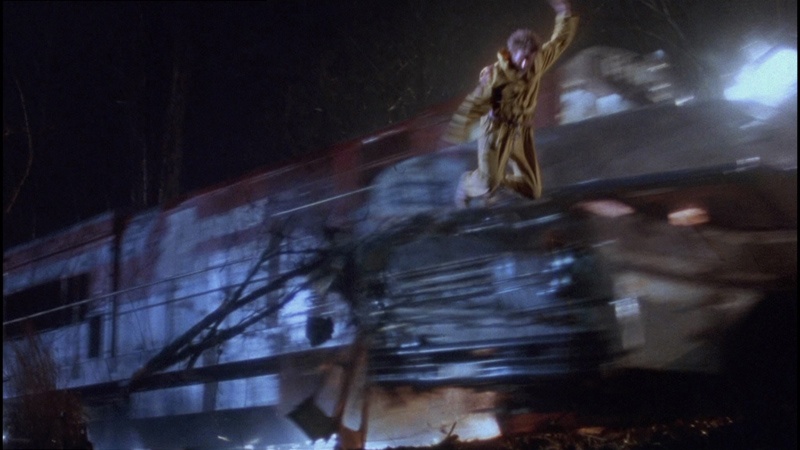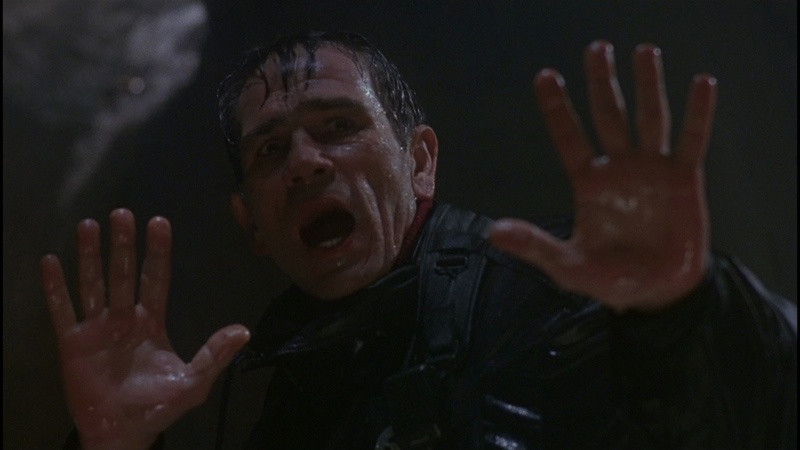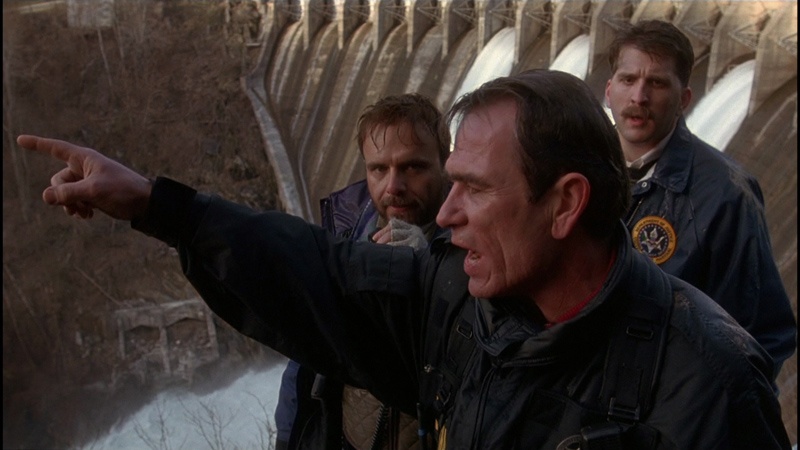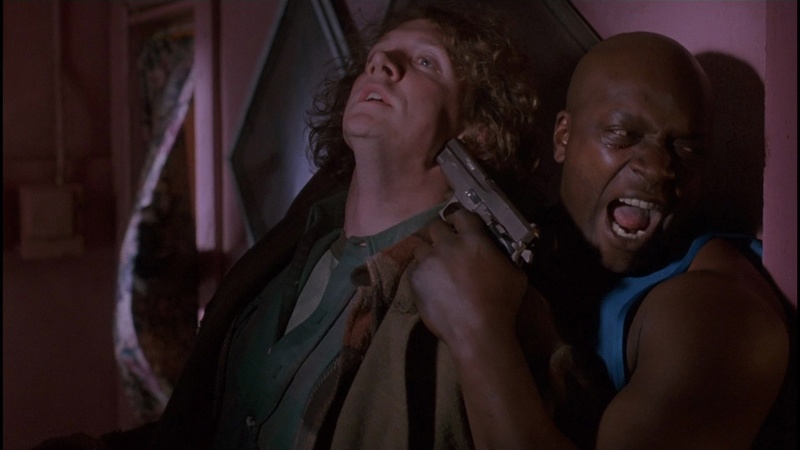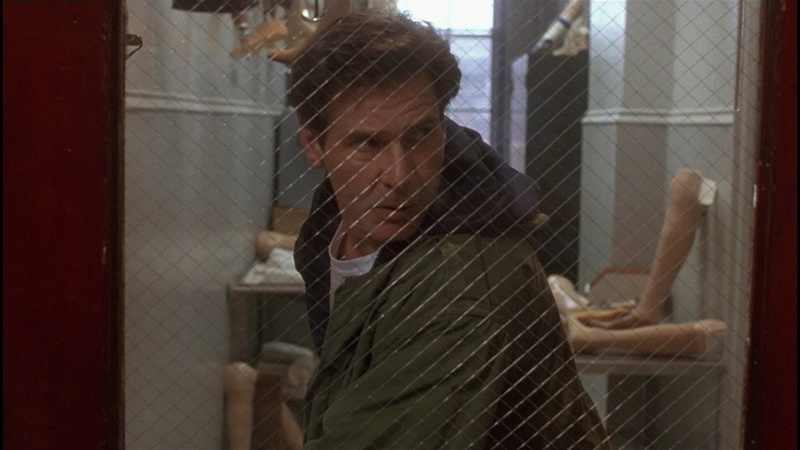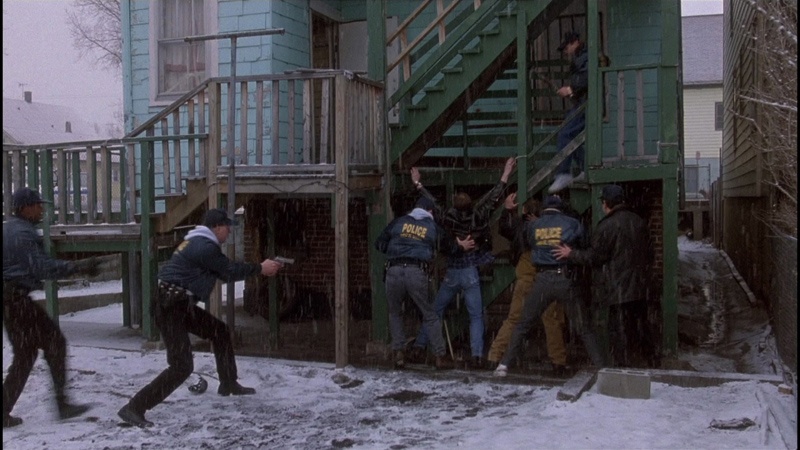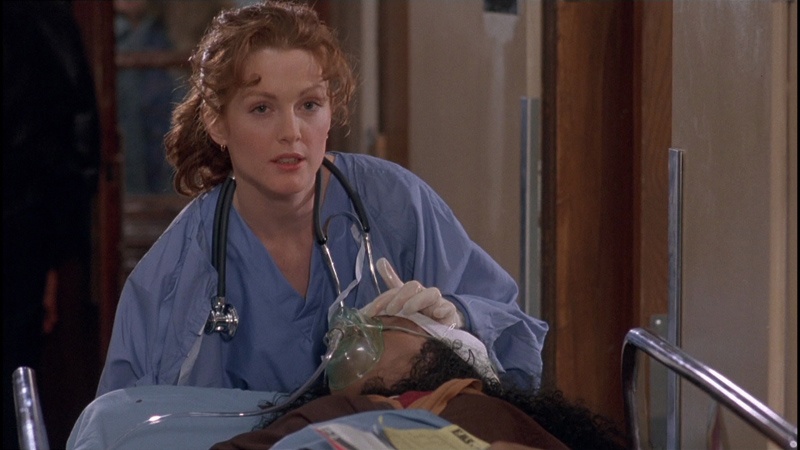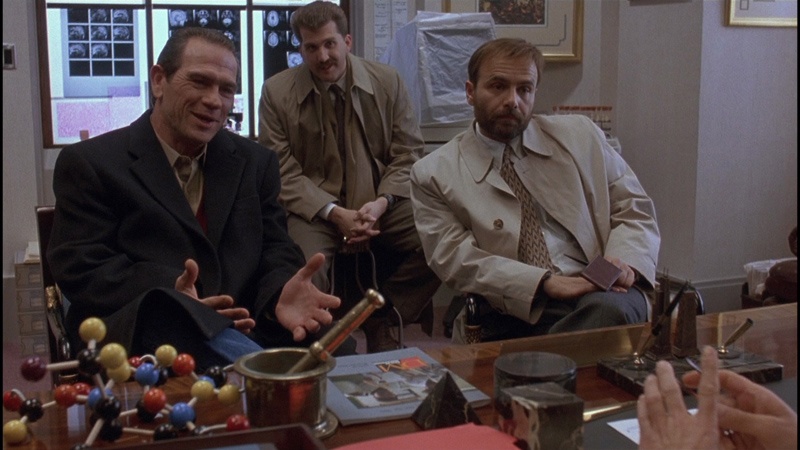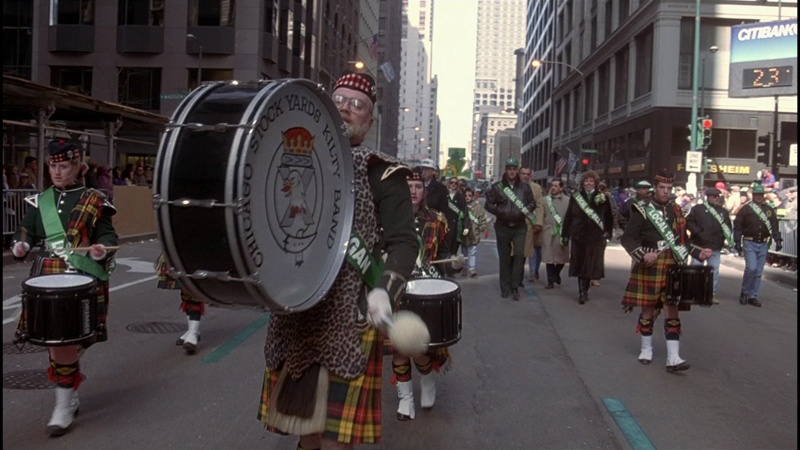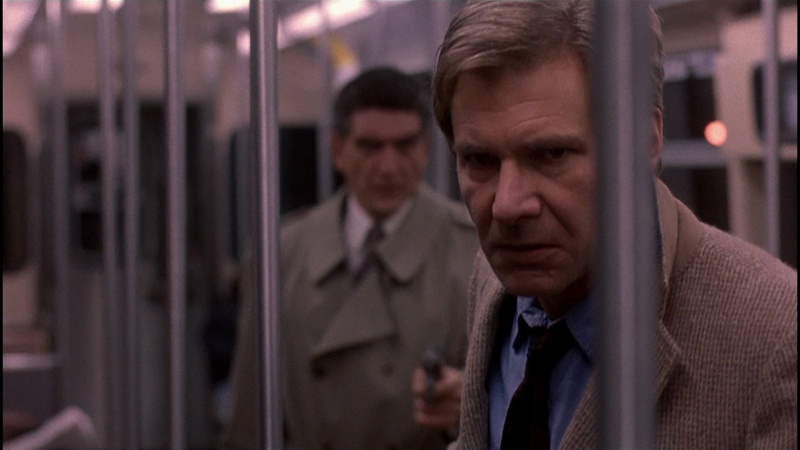|
The Fugitive
[Blu-ray]
(Andrew Davis, 1993)
Review by Gary Tooze
Production:
Theatrical:
Warner
Video:
Warner Home Video
Disc:
Region: FREE!
(as verified by the
Momitsu region FREE Blu-ray player)
Runtime: 2:10:14.807
Disc Size: 24,813,817,916
Feature Size: 22,771,599,360
Video Bitrate: 20.73 Mbps
Chapters: 42
Case: Standard Blu-ray case
Release date: September 26th, 2006
Video:
Aspect ratio: 1.85:1
Resolution: 1080p / 23.976 fps
Video codec: MPEG-2
Audio:
Dolby Digital Audio English 640 kbps 5.1 / 48 kHz / 640 kbps
Dolby Digital Audio English 192 kbps 2.0 / 48 kHz / 192 kbps
/ Dolby Surround
Dolby Digital Audio French 192 kbps 2.0 / 48 kHz / 192 kbps
/ Dolby Surround
Dolby Digital Audio Spanish 192 kbps 2.0 / 48 kHz / 192 kbps
/ Dolby Surrounds
Subtitles:
English, Spanish, French and none
Extras:
• Audio Commentary with director Andrew Davis and actor
Tommmy Lee Jones
• Anatomy of a Train Wreck (9 min)
• On the Run (23 min)
• Theatrical Trailer
Introduction: The chase has been a vital cinematic
ingredient since The Great Train Robbery of 1903. Some ten
years later, Mack Sennett's Keystone Cops brought the
concept to hilarious heights – or depths, if you prefer.
(Billy Wilder's 1959
Some Like it Hot opens with an homage.) Westerns
from the silent era through the 1930s had endless chases per
movie: Indians chasing wagon trains, cavalry chasing
Indians, outlaws chasing stagecoaches, posses chasing
outlaws, good guys in white hats chasing down runaway horses
with damsels in distress. Dramas and comedies made frequent
use of the sound stage so that filmmakers could control
every nuance of production, but were less convincing for
chase sequences, having to rely on rear projection for that
extra bit of wincing unreality. The sound stage became the
order of the day until after WWII, when more light sensitive
film became available and the camera itself became more
portable. With film noir the camera moved out on location
once again, often at night.
The idea of the chase as the basic architecture of a movie
isn't all that common in film, though it does seem to
provide the impetus for many of our dreams. Alfred Hitchcock
placed his personal stamp on the chase in the late 1930s
with
The 39 Steps and
Young and Innocent, in 1942 with
Saboteur and in 1959 in
North by Northwest. In the following decades, the
chase could be seen in such diverse films as Stanley
Kramer's 1963 interminable farce, It's a Mad, Mad, Mad,
Mad World, Sydney Pollack's romantic The Electric
Horseman, Spielberg's relentless TV movie Duel, and the
delightfully disrespectful Smokey and the Bandit.
It's there again in
The Searchers, John Ford's tale of twisted revenge
and racist hatred and also Hitchcock's introverted,
nightmarish masterpiece in the genre,
Vertigo. Satoshi Kon would bring the dream and the
chase together in his 2006 anime,
Paprika.
Though its antecedent is probably the chariot race from
Ben-Hur, the idea of a car chase being considered as
part of character development got a genre-making boost in
Peter Yates' 1968 detective drama,
Bullitt, starring Steve McQueen in the title role.
The car chase would find ferocious expression three years
later in William Friedkin's thriller,
The French Connection, where Gene Hackman terrorizes
Manhattan's population as his juggernaut chases down an
elevated commuter train through defenceless traffic and the
spare pedestrian.
It wouldn't be long before the car chase would become the
staple of comedies and thrillers alike from The Blues
Brothers and Beverly Hills Cop to The Road
Warrior and
Ronin, as each in turn tried to outdo its
predecessor in sheer carnage and automotive acrobatics.
In the mid-1960, an entire TV series (4 seasons, no less -
Ed. Now on DVD
HERE!) was developed around the basic Hitchcock
formula: Roy Huggins' memorable The Fugitive starred
David Janssen as a man wrongly accused of his wife's murder.
The police chase him from one episode to the next, as he
doggedly tracks his one-armed man. Huggins' clever amendment
was to place his hero in harm's way every time he did his
doctor thing, which was often.
The Film:
7/10
I'm off the hook about comparing the movie to the TV show, having only
seen the odd episode (it was a time of competing priorities.) But taking
it on its own, the movie is a well paced thriller, with extended action
sequences and suspenseful trips to the hospital for the hero to
"re-enter his life" and find the owner of the telltale prosthetic arm.
I've never been happy about the final act once Kimble is onto the real
culprits: Resourceful, determined, in great physical shape, yes.
Action-hero, no. On the other hand, the chemistry between Harrison Ford
and Tommy Lee Jones as Dr. Richard Kimble and U.S. Marshal Samuel Gerard
(contemporary versions of Jean Valjean and Inspector Javert) is a joy.
Even though they share the screen only briefly, we feel a connection of
mutual respect grow as Gerard gradually grasps the truth of the matter.
Nearly all the supporting characters are well cast and dynamically
presented, from Sela Ward as Kimble's wife in her very few fond and
wistful moments with Ford, to the ever-complaining Joe Pantoliano as
Deputy Marshal Renfro, Jeroen Krabbe as Kimble's respectful colleague,
and Andreas Katsulas as the professional one-armed man ("How did you
lose your arm?",Ě Gerard asks him. "In the line of duty,"
comes the telling reply.) Julianne Moore, who gets a billing far above
her importance in the film, is wasted in what is apparently conceived as
the scene that's supposed to set our minds to rest about Dr. Kimble's
true nature. ("He saved his life," Moore's Dr. Eastman replies to
Gerard's query about how the boy was doing whom Kimble redirected for
the proper emergent care.) A subplot with her and Ford was shot but
later deleted to keep the action going. Smart move.
Besides a minor bit of misdirection when the marshals listen to a taped
conversation between Kimble and his attorney, which repositions the
background train and bell sounds differently from the way we saw and
heard them, my problem with the movie has always been that I have never
found a convincing explanation of what the perpetrators planned on that
fateful night, leaving me with more questions than answers: They had the
key, but no security code. Was the one-armed man waiting for hours for
Kimble to come home? If so, where? Who was the intended victim – with
only one arm and no weapon? These aside, I continue to find the
characters seductive and movie eminently rewatchable.

Image : 5/7
NOTE:
The below
Blu-ray
captures were taken directly from the
Blu-ray
disc.
The Fugitive
in the old MPEG-2 encode is not much fun to look at, though oddly
sharper in some spots. Made almost fifteen years ago before digital
effects became the norm for dramatic thrillers and when they still had
much the same look as they had for The French Connection twenty years
earlier. The Fugitive adds extra light for indoor shots and close-ups,
perhaps to allow the movie to play better on pre-high definition
television, as it ensures greater visibility, depth of field and clarity
of focus at nearly all times.
However, viewed on smaller than 55-inch high-definition displays, the
use of extra artificial lighting strikes us as obtrusive, which it would
not in front projection or in the theater. We don't notice it when the
image is blown up to the size of a theatrical screen, but at home, the
contrast is sometimes excessive. This is the case for many movies that
use auxiliary lighting at the sides and behind, to help set off one
character or object from another. There's not a whole lot that can be
done about it for home video, for how would screen size be factored in?
Once again, the difference between the standard and high definition
discs, while not something that knocks one's socks off in an A/B
comparison, is more felt that observed. Differences in resolution,
sharpness, color contrast and brightness are barely discernable, but our
emotional involvement on the
Blu-ray, despite all, is not insignificant
by comparison. We might not even have been aware that the movie was as
flat as it was on DVD until we see it in high-def. Motion artifacts,
too, are minimized in this
Blu-ray. One minor criticism that is entirely
the doing of Warner's presentation for this disc: the decision to fill a
16x9 screen, or nearly, at 1.77:1 instead of the theatrical 1.85:1. The
difference is minor and subtle, but there's really no good reason not to
conform to the director's intentions here.
That said, the image is, except for the more carefully lit shots,
noticeably soft, mushy and grainy – one wonders if this is entirely the
result of film stock and lensing. The print used appears to be quite
clean, with noiseless, if not solid blacks and a natural rendering of
colors and flesh tones. Much of the color for outdoor shots, with the
notable exception of the St. Patrick's Day Parade, is muted. On the
other hand, the blending of live action and matte shots in the train
crash is far from seamless when viewed in HD – again, not a fault of the
transfer.
CLICK EACH
BLU-RAY
CAPTURE TO SEE ALL IMAGES IN FULL 1920X1080 RESOLUTION
Audio :
Perhaps even
more than the image quality, audio suffers at the hands of the early
adopter of the high definition medium. When The Fugitive came out on
Blu-ray, lossless or uncompressed audio tracks were not yet the norm.
Many of us, myself included, had not experienced such a thing in a home
theatre environment. For a long time I preferred a simple two-channel
mix, played through a proper outboard digital-to-analogue converter, to
the thick non-dynamic Dolby Digital and DTS surround mixes. And this is
what we have here at a subdued 48 kHz / 640 kbps.
We think immediately of the astonishing train wreck: the screeching of
metal against metal, train against bus, the vain attempt to brake what
will shortly be crashing tons of engine and freight as they scream and
crush their way through the hillside in an unwitting attempt to turn
Harrison Ford into a waffle. I suspect our imagination enhances that
which is merely loud and scary but lacks weight, power or truly
frightening scream. Still, I'll bet it's there, somewhere, on the
soundtrack, but can't make its way through the thick of traditional
compressed audio.
For a thriller, The Fugitive is relatively subtle in respect to its
audio. There's not a whole lot to show off one's audio system in this
movie: some nice helicopter effects and the tunnels and falling water
around the dam, traffic sounds: everything is effectively designed to
support drama, place and mood. What is wanted is atmosphere, clear
dialog, and a great train wreck. And we almost get it. Let's hope for a
reissue with a DTS-HD MA mix and an improved image. Gary's
Momitsu
has identified
it as being a region FREE disc playable on
Blu-ray
machines worldwide.

Extras :
The
scene-specific audio commentary (alas!) heads the cast of bonus
features, all available on the previous DVD. Director Andrew Davis leads
the conversation, while Tommy Lee responds to his questions every now
and then. Davis thoughtfully takes us through production issues like the
staging of the train wreck (which is expanded upon in the featurette on
the same subject), the Chicago parade, the tunnel and waterfall jump. He
also talks about the deleted subplot between Harrison Ford and Julianne
Moore. There are also two featurettes that deal with the staging and
effects for the train wreck and the shooting and scripting of Kimble ‚€œon
the run‚€Ě (9 & 23 minutes, respectively.) No deleted scenes (the
Ford/Moore bits would have been nice) and, nothing presented in HD.
BOTTOM LINE:
Since it's original release, there have been reports that Warner
substituted a VC-1 transfer with some modest improvement in
the image. On the basis of these reports I purchased a new
copy only last month, however, Cinema Squid indicates it is
the same old MPEG-2. In any case the audio mix remains
compromised. While this is the best Fugitive available for
home video at the present time, I long for a re-release with
high definition sound, perhaps even an improved picture and
a high def presentation of a bonus feature or two!
Leonard Norwitz
LensViews
March 30th, 2007
Revisited: December 1st, 2010
|
![]()
![]()

![]()
![]()
![]()
![]()

![]()
![]()


